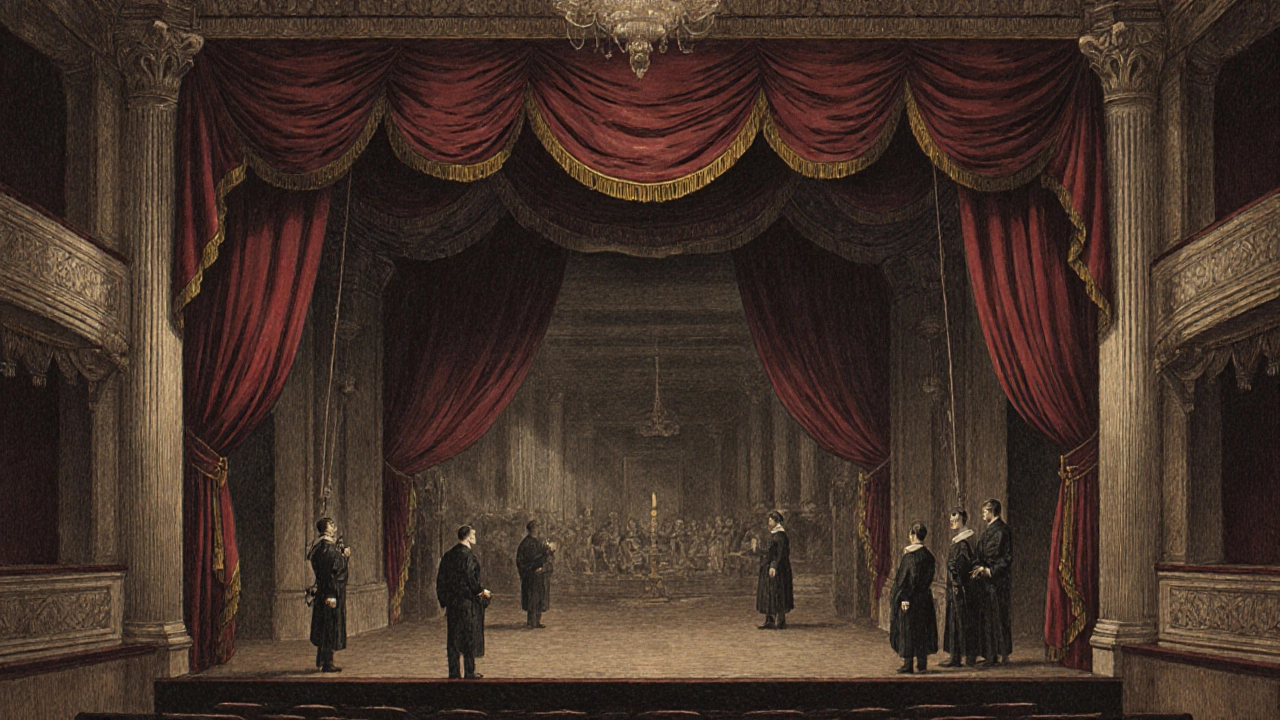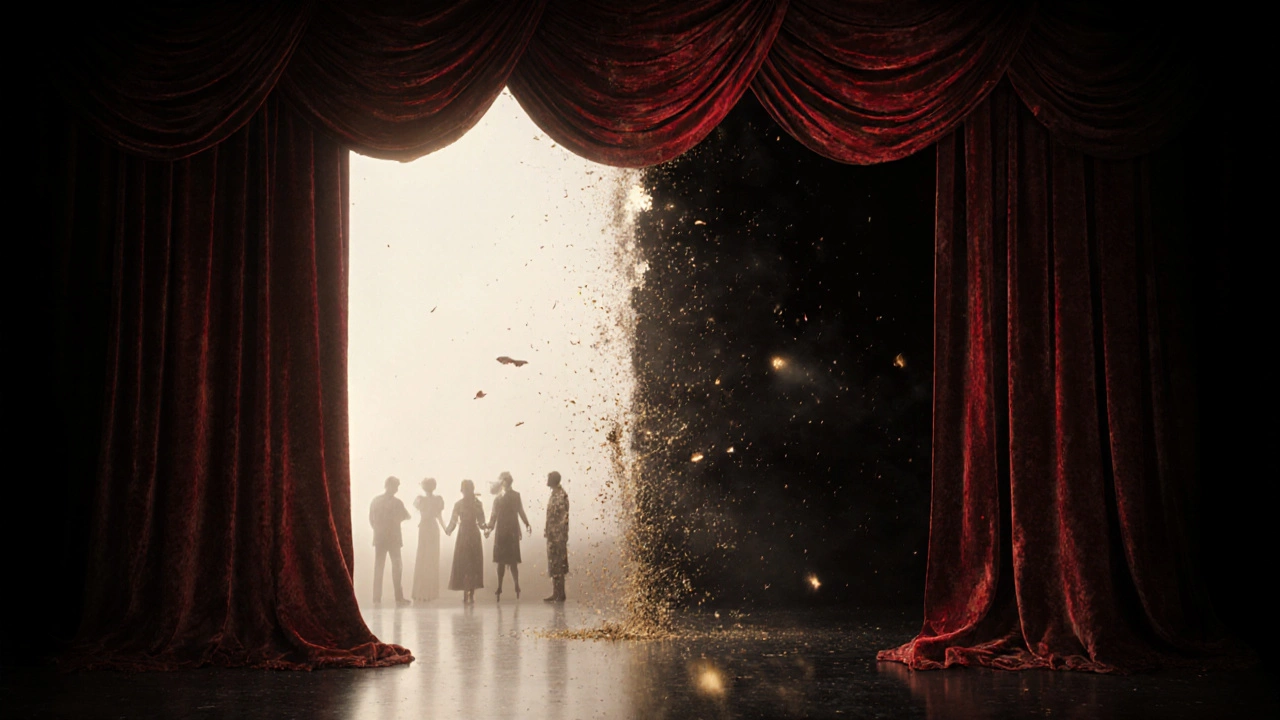When you walk into a theatre, the first thing you see isn’t the stage-it’s the curtain. But which one? If you’re sitting in the front row, the curtain closest to you isn’t the one that rises to reveal the show. It’s the one that hides the backstage chaos, the one that drops before the lights dim, and the one that stays in place even when the performance ends. That curtain is the proscenium curtain.
Why the Proscenium Curtain Is the One Near the Audience
The proscenium curtain, sometimes called the main curtain or grand drape, hangs right in front of the stage opening-the proscenium arch. It’s the barrier between the audience’s world and the performers’ world. In most traditional theatres, it’s the first and last thing the audience sees. It’s not decorative fluff. It’s functional architecture.
Think of it like a front door. You don’t walk into a house through the garage. You use the front door. Same here. The proscenium curtain is the official entry point to the performance. It’s heavy, often lined with velvet or fire-retardant fabric, and designed to open and close smoothly during blackouts. Its position is fixed: directly between the audience and the stage. No other curtain sits closer.
Other Curtains in the Theatre (And Why They Don’t Count)
There are other curtains on stage, but none are as close to the audience as the proscenium curtain. Here’s what else you might see:
- Traveler curtains: These slide open left and right, often used in smaller venues. They’re still behind the proscenium curtain in most cases.
- Tab curtains: Vertical panels that move side to side. Used for scene changes, not audience framing.
- Grand drape: This is just another name for the proscenium curtain. Don’t get confused by the fancy term.
- Backdrop curtains: These hang at the rear of the stage to show scenery. They’re farthest from the audience.
- Legs and borders: These are side and top curtains that frame the stage area. They’re part of the set, not the audience-facing barrier.
None of these are positioned in front of the proscenium arch. None are the first thing the audience sees. Only the proscenium curtain is.
How It Works During a Performance
Before the show, the proscenium curtain is closed. Lights dim. The house goes quiet. Then-slowly-it opens. That moment is intentional. It’s a signal: the world of the play is about to begin. After the final bow, it closes again. Sometimes it closes halfway, sometimes fully. Either way, it’s the curtain that separates the performance from the real world.
Some modern theatres use automated systems with silent motors and counterweights. Older ones still use manual ropes and counterbalancing. But the function stays the same: control access to the stage. And because it’s mounted directly in front of the audience’s view, it’s the one they’re closest to.

Why This Matters for Designers and Builders
If you’re designing a theatre space-or even just adding a stage to your home-you need to know where the proscenium curtain belongs. Its placement affects sightlines, acoustics, and even safety. Building codes often require it to be fire-rated. The fabric must meet Class A flame spread standards. The track system must handle weight without sagging.
Home theatres sometimes skip the proscenium curtain entirely. But if you want that authentic feel-the drama of the curtain rising-you need to install it correctly. It should be mounted at least 12 inches behind the front edge of the stage apron. Too far forward, and it blocks the view. Too far back, and it loses its impact.
Materials and Styles That Make a Difference
Not all proscenium curtains are the same. In historic theatres, you’ll find heavy brocade or silk with gold trim. In modern venues, it’s often blackout velvet with a matte finish to reduce glare. The color matters too. Deep reds and burgundies are classic-they absorb light and create a sense of warmth. Black is used in experimental spaces to disappear entirely.
Weight is another factor. A full-size proscenium curtain can weigh over 200 pounds. That’s why you need proper rigging: counterweights, pulleys, or motorized tracks. A poorly installed curtain won’t open smoothly. It might snag. It could even fall. That’s not just embarrassing-it’s dangerous.

Real-World Example: The Royal Opera House, London
At the Royal Opera House in Covent Garden, the proscenium curtain is made of hand-woven silk and wool, lined with fireproof material, and weighs nearly 300 pounds. It takes four stagehands to manually open it during early morning rehearsals. It’s been in use since 1858, with only minor upgrades. It’s not just fabric-it’s history. And it’s the first thing every audience member sees.
Even in smaller community theatres, the same principle holds. The curtain closest to the audience is the one that marks the boundary between reality and performance. It’s not optional. It’s essential.
What Happens If You Skip It?
Some modern performance spaces-like black box theatres-do away with the proscenium curtain entirely. The stage is open to the audience. But that changes the experience. Without a curtain, there’s no build-up. No mystery. No transition. The actors walk on, and the audience sees everything-lights, wires, crew members adjusting props. It’s raw. It’s real. But it’s not traditional.
If you’re aiming for a classic theatre feel, skipping the proscenium curtain is like removing the front door from a house. You can still get inside. But you lose the ritual. You lose the drama.
Final Answer: The Proscenium Curtain Is the One
So, what curtain is closest to the audience? The proscenium curtain. It’s not the backdrop. Not the legs. Not the border. It’s the heavy, framed, often velvet curtain that opens and closes at the start and end of the show. It’s the one that’s mounted directly in front of the stage opening. It’s the one you’re looking at before the lights go down. It’s the one that makes the performance feel sacred.
If you’re building, renovating, or just curious-remember this: in every traditional theatre, from Broadway to community halls, the proscenium curtain is the audience’s first and last connection to the stage. Everything else is just scenery.
Is the proscenium curtain the same as the grand drape?
Yes, they’re the same thing. "Grand drape" is just another term for the proscenium curtain, especially in older or more formal theatre settings. Both refer to the main curtain that opens and closes at the front of the stage, directly facing the audience.
Can a theatre have more than one curtain closest to the audience?
No. Only one curtain is positioned directly in front of the proscenium arch and between the audience and the stage. Other curtains-like travelers or tabs-may move in front of the stage, but they’re behind the proscenium curtain in standard theatre design. The proscenium curtain is always the closest to the audience.
Do all theatres use a proscenium curtain?
Most traditional theatres do. But modern black box or thrust stages often skip it to create a more immersive experience. In those spaces, the audience surrounds the stage, so a front curtain isn’t practical. But if you’re building a standard proscenium theatre, the curtain is required for both function and tradition.
What’s the best fabric for a proscenium curtain?
Heavy, fire-retardant velvet is the industry standard. It absorbs sound, blocks light completely, and has a rich, luxurious look. Synthetic blends like polyester-velvet are common in budget setups, but natural wool-blend velvet is preferred in professional theatres for its durability and drape. Always check local fire codes-some regions require Class A ratings.
How high should the proscenium curtain hang?
It should hang just above the top of the proscenium arch, with enough clearance for the curtain to fully open without hitting the arch or any overhead lighting. Typically, it’s mounted 12 to 18 inches behind the front edge of the stage apron. Too close, and it blocks the view. Too far, and it loses its visual impact.
